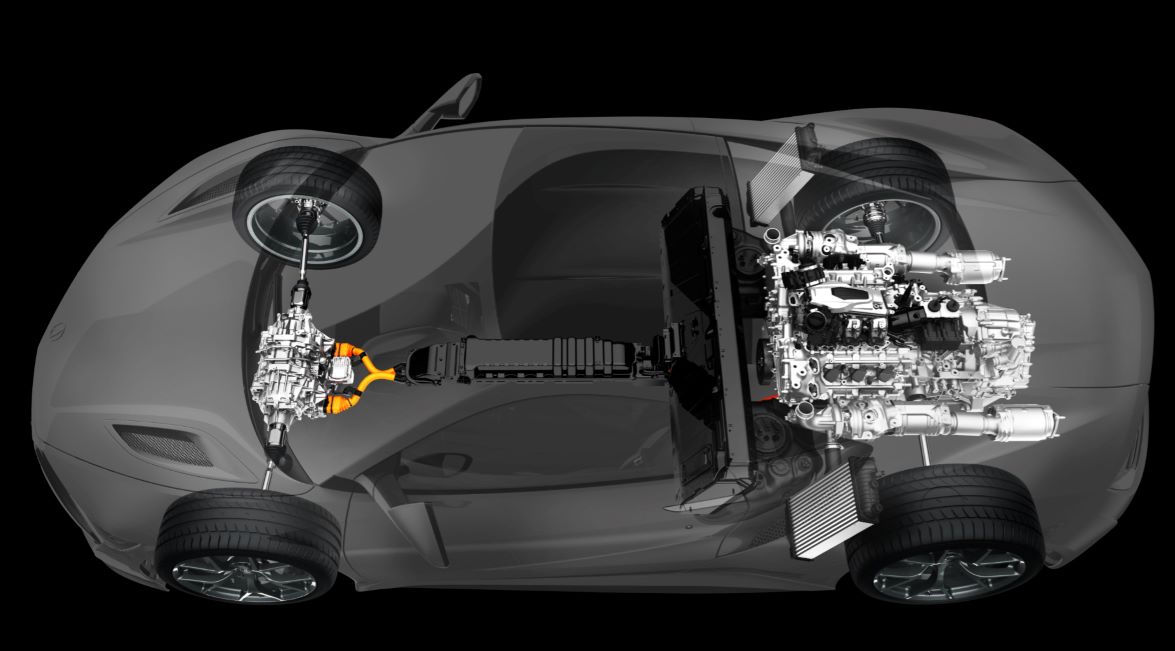
Acura takes the wraps off its highly anticipated next-generation NSX supercar, designed to deliver a groundbreaking “New Sports eXperience”
Twenty-five years after the debut of the original, paradigm-shifting NSX supercar, Acura revealed the production version of its highly anticipated successor—the next-generation Acura NSX, developed and produced in the U.S.—to the world’s auto media at the 2015 North American International Auto Show today. The production model, in a scintillating NSX Red finish, took the stage with a growl from its twin-turbocharged engine.
The next generation NSX showcases the production styling, design and specifications of Acura’s mid-engine sports hybrid supercar, and Acura announced key details of the all-new vehicle’s design and performance. The company will begin accepting custom orders for the new NSX starting in the summer, with customer deliveries expected later in the year.
Specifically created to bring a “new sports experience” to the supercar segment, the NSX challenges conventional beliefs about supercars — much as the first generation did a quarter century ago. The approach is realized through an all-new power unit—a twin-turbocharged 75-degree DOHC V6 engine with a 9-speed dual clutch transmission (DCT) and three-electric motor Sport Hybrid system—integrated with an ultra-rigid and lightweight multi-material body with world’s-first material applications and manufacturing processes. Developed under the concept of a “human-centered supercar,” a car that puts the driver first in every aspect of its design, the next-generation NSX will leverage its state-of-the-art hybrid supercar power unit, body and chassis to deliver exceptionally intuitive and immediate response to driver inputs.
“Our commitment was to create an all-new NSX that is true to the heritage of NSX—a supercar that delivers a new driving experience, one where every part of the vehicle is respectful of the smartest part of the car, the driver,” said Mike Accavitti, senior vice president and general manager of the Acura division. “The soul of a car is the emotional connection it makes with the driver. With the NSX, that connection will be intense and immediate.”
As the pinnacle representation of Acura performance and prestige, the NSX was introduced at the auto show under the theme of “Precision Crafted Performance.” The theme was the original tagline for the Acura brand, a guiding force behind the development of the original NSX and a critical component of its launch.
The development of next-generation NSX, driven by precision crafted performance, has resulted in a clean-sheet design, which involved nearly three years of intensive development effort by a global design and engineering team led by engineers at the company’s development center in Raymond, Ohio.
“The NSX reflects Acura’s American roots and makes a powerful statement about the strong role being played by our North American operations in envisioning and building the future of Acura,” said Erik Berkman, executive vice president of the Acura Business Planning Office.
“Our global team embraced the challenge to create a new sports car experience, leveraging new technology to deliver incredibly vivid performance in a vehicle that responds intuitively and immediately to the will of the driver,” said Ted Klaus, chief engineer and global development leader of the new NSX. “The NSX delivers pinnacle supercar performance, with zero-delay acceleration and exhilarating, confidence-inspiring driving dynamics.”
Interwoven Dynamic Exterior Design
“The new NSX is a product of what we term ‘Interwoven Dynamic’ design,” said Michelle Christensen, NSX exterior design project leader. “It represents the ideal blending of exotic sports car form and supercar function.”
The NSX body features classic low and wide proportions married to modern and alluring surfacing, an aggressive front design, and tail lights that pays homage to the original NSX. The signature side intake and floating C-pillar collects air to feed the mid-mounted engine and directs airflow over the rear deck to increase downforce. To accommodate the new longitudinally mounted twin-turbo V6 and 9-speed DCT, the production vehicle was lengthened (+3 inches) and widened (+1 inch) with a slightly more cab-forward package, compared with the proportions of the NSX Concept shown in 2012.
Every element of the exterior body design has been carefully fashioned for total airflow management for both stability-enhancing downforce and vehicle systems cooling. The NSX has undergone extensive testing at the company’s state-of-the-art wind tunnel in Raymond, Ohio, leading to a number of significant changes from concept to final body design, including modified hood vents, new front fender vents, modified side air intakes, and an optimized deck spoiler.
Dimensions:
| NEW NSX | 2013 NSX Concept | Diff (in.) | 2005 NSX | Diff (in.) | |
| Length | 176 in. (4470 mm) |
172.8 in. (4390mm) | +3.1 | 174.2 in. (4425 mm) |
+1.8 |
| Width | 76.4 in. (1940 mm) |
75.4 in (1915 mm) |
+1.0 | 71.3 in. (1810 mm) |
+5.1 |
| Height | 47.8 in. (1215 mm) |
47.2 in. (1200 mm) |
+0.6 | 46.1 in (1170 mm) |
+1.8 |
| Wheelbase | 103.5 in. (2630 mm) | 102.8 in. (2610 mm) |
+0.8 | 99.6 in. (2350 mm) |
+11.0 |
| Front track | 65.2 in. (1655 mm) |
– – | – – | 59.5 in. (1510 mm) |
+5.7 |
| Rear track | 63.6 in. (1615 mm) |
– – | – – | 60.7 in. (1540 mm) |
+3.0 |
Human Support Cockpit
“Consistent with the ‘human-centered supercar’ development concept, the NSX was designed from the inside out with an uncompromising focus on the driver,” said Johnathan Norman, NSX interior design project leader. “Like the original NSX, we created a ‘Human Support Cockpit’ that provides exceptional driver control, visibility and packaging, but further advanced to meet the extreme performance expectations of a modern supercar.”
The NSX interior boasts exceptional forward visibility, simple and intuitive controls, and class-leading ergonomics—most notably the seat, which features top-class holding performance with outstanding comfort and easy ingress/egress.
The NSX’s instrument cluster features a dynamic TFT display that responds to changes in the driver-selectable Integrated Dynamics System with pertinent graphics and information. The center console holds the Power button that readies the sport hybrid powertrain, nested in the center of the new Integrated Dynamics System dial control. Interwoven under the handcrafted leather dash panel is the exposed midframe—a functioning chassis structural member that reflects the design aesthetic of a naked sport bike. An ultra-thin, yet super strong A-pillar design and low-mounted instrument panel minimize obstructions to the driver’s view of the road.
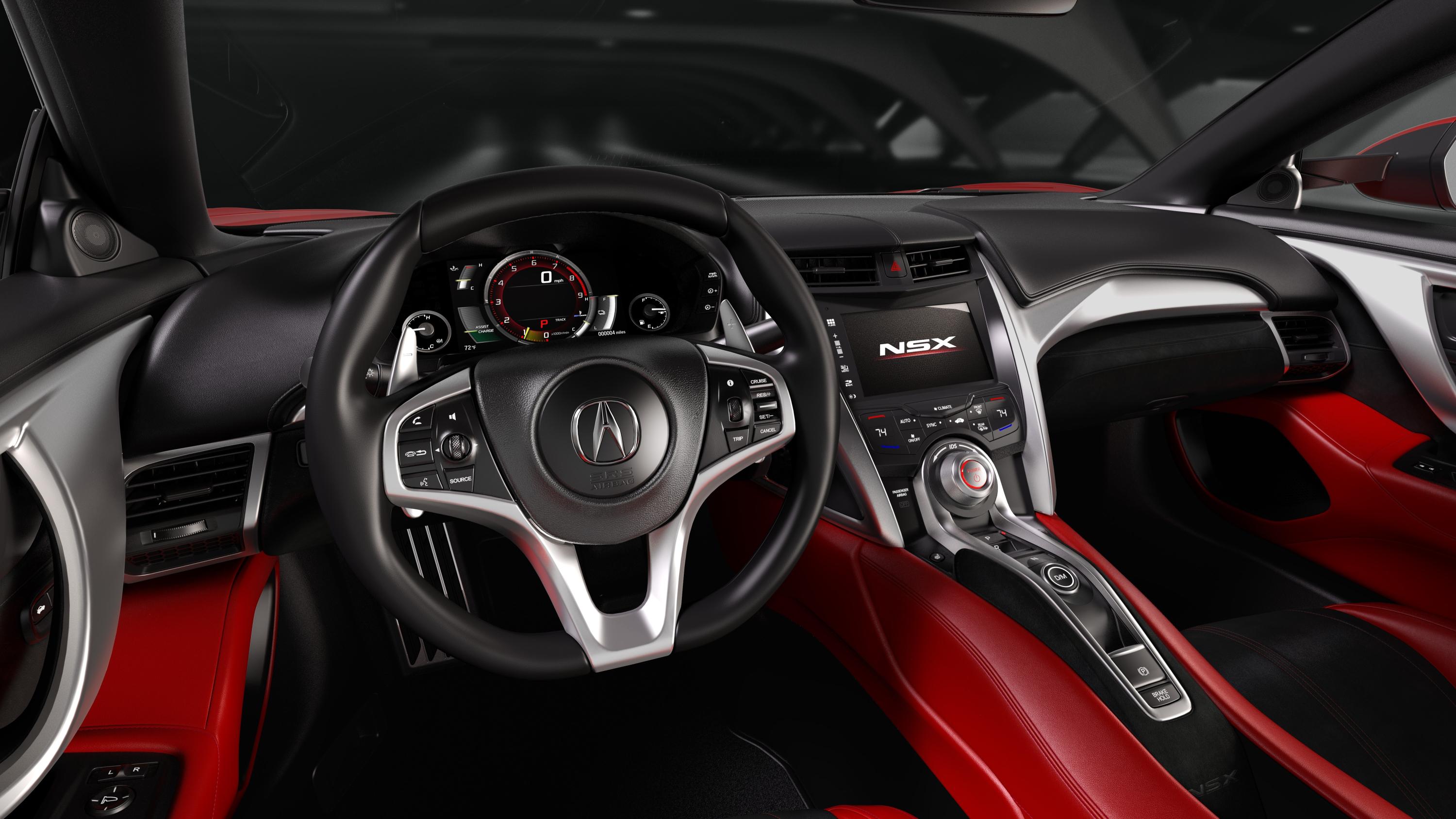
Sport Hybrid Power Unit
In keeping with the foundational philosophy of the original NSX, the next-generation NSX is designed to provide a new sports car experience that maximizes the capabilities of the driver, delivering exceptionally intuitive and confidence-inspiring response “at the will of the driver.”
Acura engineers leveraged the company’s expertise both with high-performance engine and hybrid electric-drive technologies, as well as its two decades of experience with industry-leading dynamic torque-vectoring technologies, including Super-Handling All-Wheel Drive (SH-AWD), to create the most sophisticated, technologically advanced and intelligent powertrain in the supercar universe.
At the heart of the NSX’s performance capabilities is an all-new mid-mounted, 75-degree, DOHC V6 engine with twin turbochargers mated to an Acura-developed 9-speed DCT. The V6 engine employs a race-inspired compact valve train and dry sump lubrication system to help lower the center of gravity. The all-new 9-speed DCT delivers synapse-quick gear changes and rev-matching downshifts. The rear direct-drive electric motor, housed between the engine and transmission, supports acceleration, braking and transmission shifting performance. The NSX’s front wheels are driven by twin independent high-output electric motors which deliver instantaneous torque response and dynamic left-to-right torque distribution.
The NSX uses its front electric motors for dynamic torque vectoring in addition to enhancing acceleration and braking performance. The result is an instantaneous “zero delay” launch performance and handling response that seems to anticipate the driver’s desire. The NSX has undergone extensive testing at some of the world’s most challenging race circuits, including the famed Nurburgring.
Advanced Multi-Material Body
Also in keeping with the legacy of NSX—the world’s first all-aluminum supercar—the new NSX features an innovative new multi-material body design with world’s-first material applications and construction processes.
The NSX body utilizes a space frame design—an internal frame constructed of aluminum, ultra-high strength steel and other advanced materials. Anchored by a carbon fiber floor, torsional and bending forces are taken up entirely by this ultra-rigid structure which also utilizes advanced joining technologies.
The NSX features world’s-first casting technology that combines the design and manufacturing flexibility of a casting process with the strength and elongation properties of a forged material, enabling significant weight reduction. The body panels are composed of a combination of aluminum and sheet molding composite (SMC).


Advanced Sport Package
The NSX features an “Advanced Sports Package” with placement of key powertrain components –the mid-mounted engine, twin front motors and Sport Hybrid battery pack and power control unit – optimized to concentrate vehicle mass low and toward the center of the vehicle, to further enhance dynamic response. The combination of this packaging concept and the lightweight body give the NSX the lowest center of gravity in its class.
The NSX utilizes a fully independent, all-aluminum front and rear suspension and puts its considerable power down through ContiSportContact™ high-performance tires—245/35Z R19 front and 295/30Z R20 rear—mounted on 19×8.5 inch front and 20×11 inch rear aluminum alloy wheels. Powerful, natural and confident braking performance is provided by 6-piston front and 4-piston rear monoblock calipers squeezing ultra-high performance carbon-ceramic brake discs.
Handling is greatly enhanced by Sport Hybrid Super-Handling All Wheel Drive (Sport Hybrid SH-AWD), enabling lightning-quick response to all driver inputs—steering, braking and throttle—along with the stability, control and launch performance of all-wheel drive. Agile Handling Assist (AHA) uses the subtle application of brake torque to further enhance yaw response and dynamic stability.
The NSX’s dial-operated Integrated Dynamic System features Quiet, Sport, Sport+ and Track modes. The system adjusts engine, motor, transmission and chassis response, as well as the engine sound level, based on the needs of the driver and driving environment. Quiet mode enables electric-only driving at lower speeds for short durations. Dynamic vehicle responses become increasingly sharp as the driver moves from Sport to Sport+ mode and, finally, to Track mode, where the NSX reveals the full spectrum of its performance capabilities.
The NSX also features a “launch” function to achieve the ultimate in “zero delay” launch performance, aided by both the engine and three electric motors.
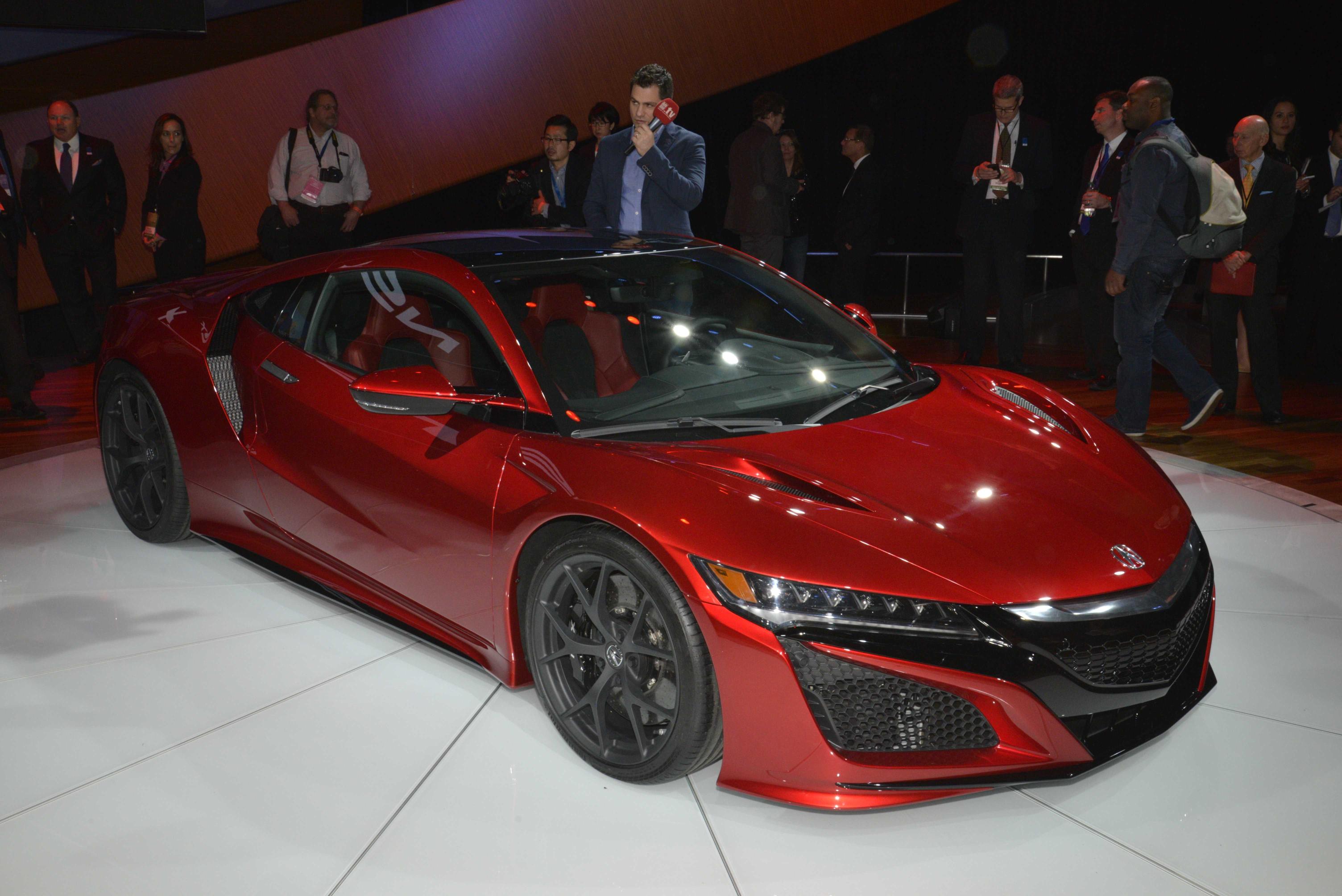
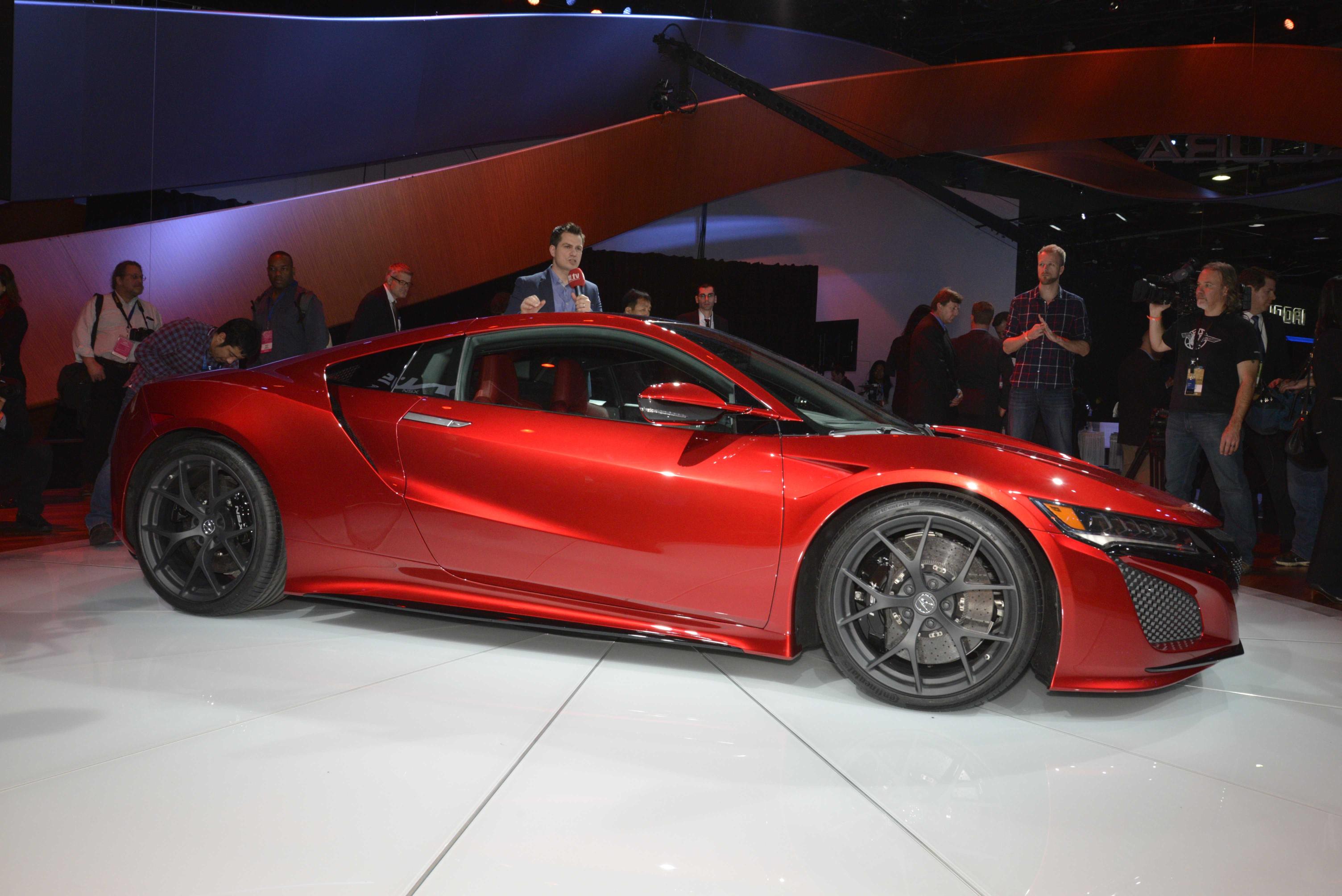
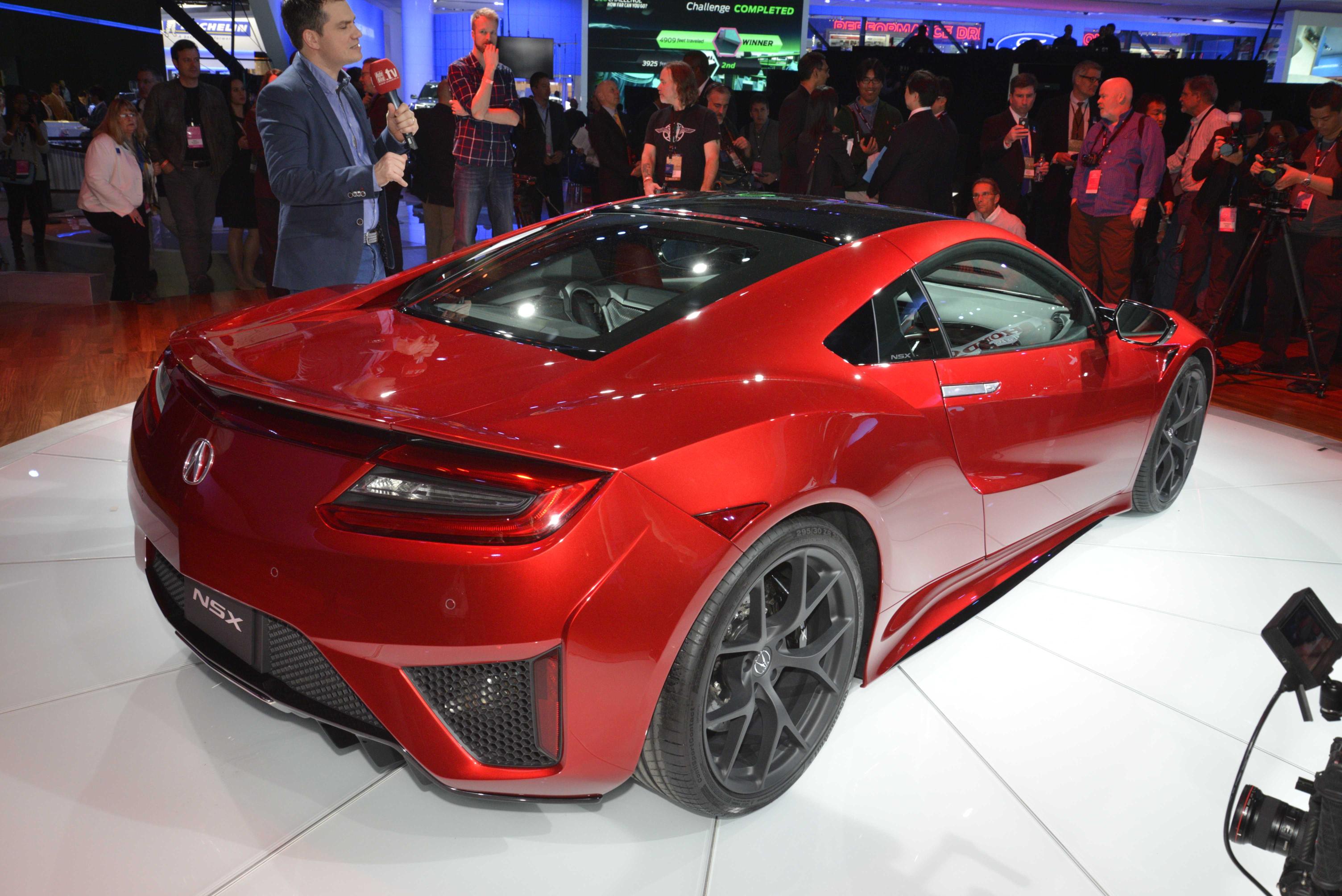
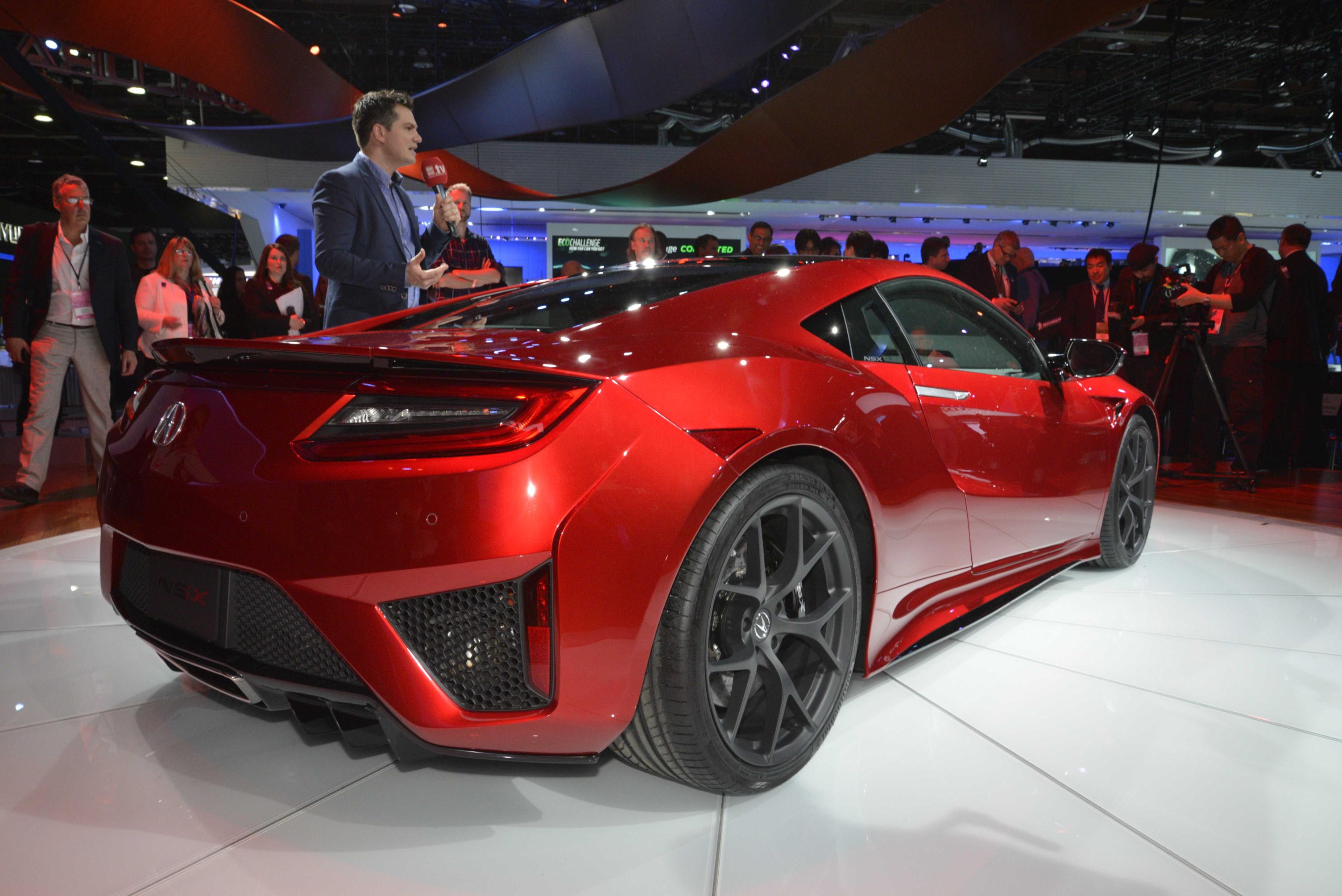

New Production Facility
The NSX will be manufactured exclusively at the Performance Manufacturing Center (PMC) in Marysville, Ohio, where approximately 100 highly-skilled associates will conduct full body construction, paint, and final assembly using domestic and globally-sourced parts.
The PMC and its processes have been developed to perfectly blend associate craftsmanship and technology in a new approach to manufacturing. By in-housing the body construction, Acura maintains complete control over total body quality, including critical strength, suspension accuracy, and fit and finish—from initial construction all the way to final assembly.
Associates will utilize innovative techniques to deliver next-generation craftsmanship and world-class quality in the realm of specialized, supercar vehicle production.
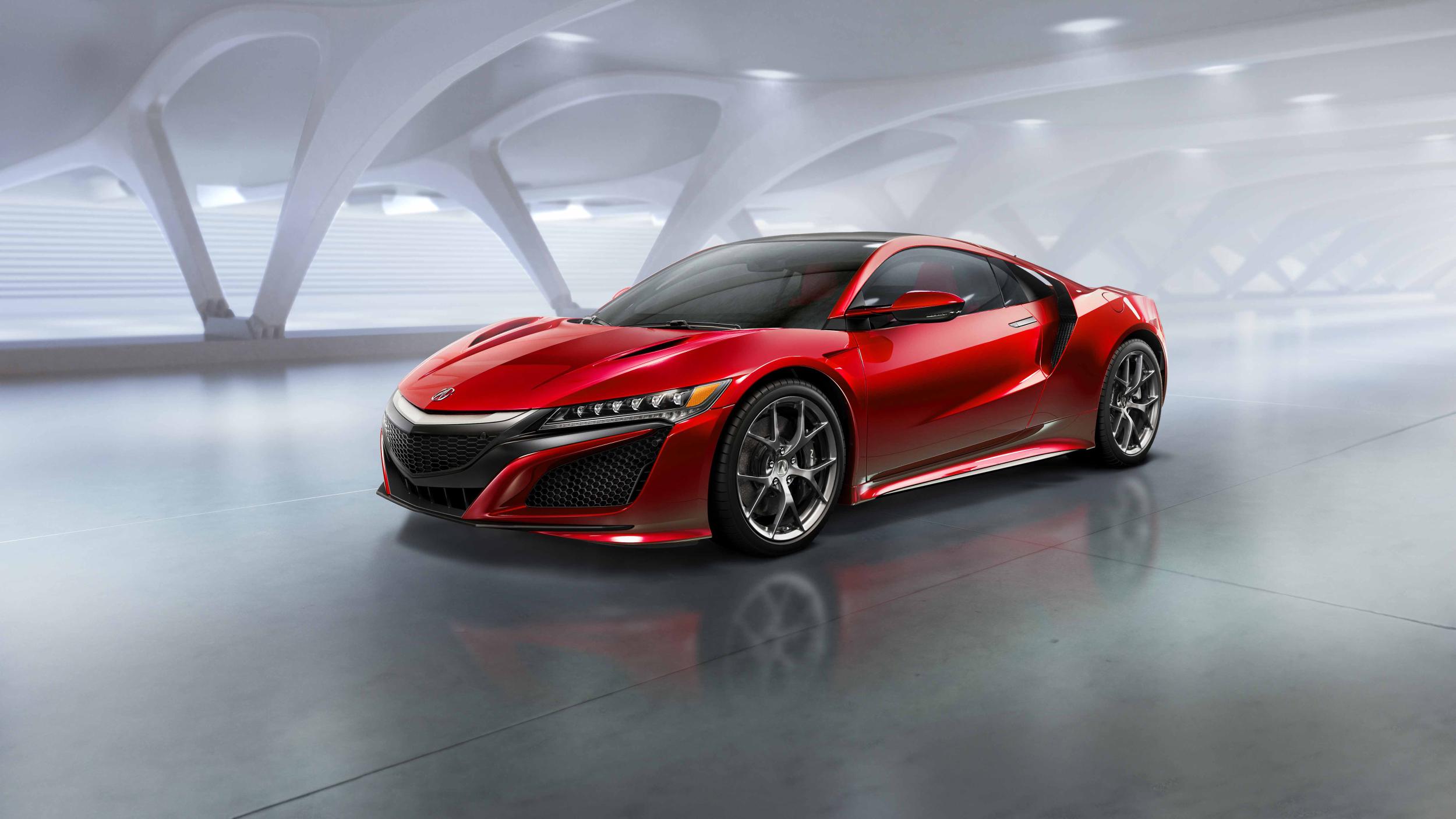

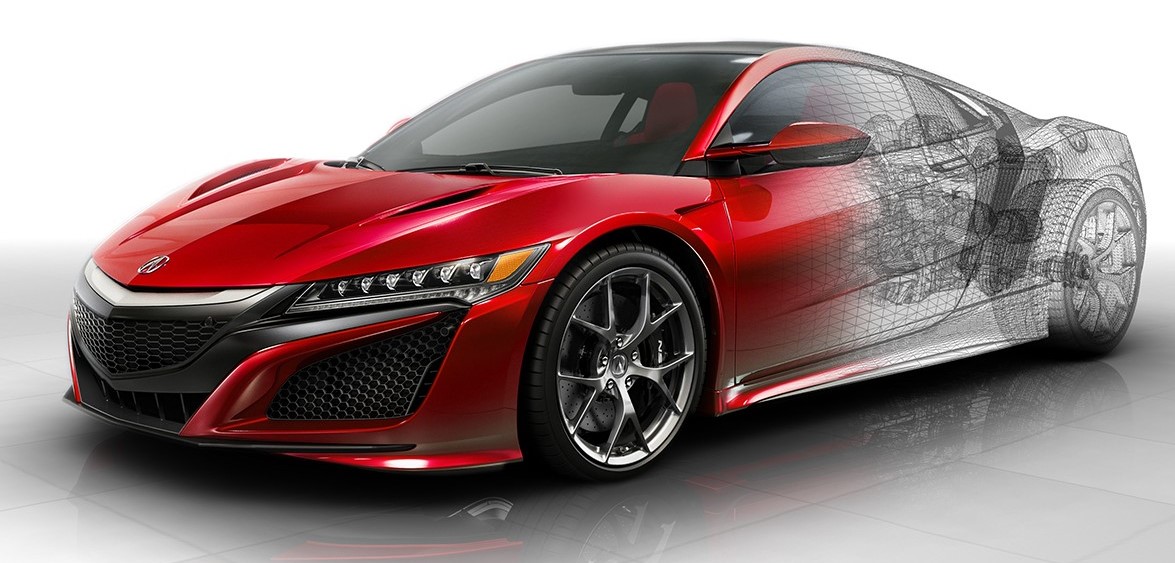
- New information disclosed on innovative powertrain, body and manufacturing technologies further solidifies the NSX’s position as a world-class supercar
- NSX legacy of innovative, lightweight body design for high performance is advanced with world’s first automotive application of ablation casting
- Total airflow management design strategy employed to achieve world-class supercar performance
Apr 23, 2015 – DETROIT — In advance of the market launch of the highly anticipated next generation Acura NSX, the engineers leading the supercar’s development shared new technical details and design strategies with the automotive engineering community at the April 22nd SAE Detroit Section dinner, held in conjunction with the SAE 2015 World Congress and Exhibition. Additional information about the team’s efforts to achieve a true “New Sports Experience” included details of the NSX’s world’s first body construction process that helped create a multi-material space frame resulting in class-leading body rigidity, the advanced total airflow management system and an update on NSX’s power unit specifications.
Ted Klaus, chief engineer and global development leader of the new NSX, introduced key powertrain, body and dynamic performance engineers who shared new product and technical details in their related areas of the development. The unprecedented sharing of technical details prior to the car’s market introduction reflects the desire of the NSX development team and the company to inspire the imagination of automotive and technology enthusiasts along with the next generation of engineers.
“Our goal is to create something altogether new and exciting, something that advances the concept of a next generation supercar in the spirit of the original NSX,” said Klaus. “In order to provide NSX-level value, we needed to push ourselves to experiment with, refine and then realize many new technologies.”
Significant technical revelations concerning the NSX included:
- The NSX includes Acura’s first use of a revolutionary multi-material space frame design that delivers class-leading body rigidity while remaining lightweight.
- World’s first automotive application of new ablation casting1 technology resulting in world-class body rigidity for ultimate handling and control.
- World’s first use of a three-dimensionally formed, ultra-high-strength steel A-pillar, supporting class-leading rigidity and crash performance while providing outstanding outward visibility.
- The NSX achieves top-in-class aerodynamics targets without the use of active aerodynamic elements, while its three-motor Sport Hybrid power unit is cooled through 10 heat exchangers all thanks to a total airflow management strategy that maximizes the flow of air around and through NSX.
- Displacement of the NSX’s all-new twin turbo V-6 engine was confirmed to be 3.5-liters.
- The NSX will mark the introduction of the most capable and highest torque capacity Super Handling All-Wheel Drive system in Acura history.
- The latest proprietary logic advances Acura’s two decades-long pursuit of Super Handling that proactively responds to driver inputs, allowing the NSX to achieve a new level of line trace while at the same time intelligently supporting the driver in changing environments.
Additional details on each of these engineering achievements follow:
Multi-Material Body
Acura’s First Application of a Multi-Material Body with Space Frame Construction
Developing the Most Rigid-in-Class, Multi-Material Body
At the core of the NSX mission to deliver timeless sports car values is an aluminum-intensive, multi-material space frame. This innovative space frame represents a next-generation leap in body design with class-leading technology that is exclusive to Acura within the automotive market. Based on internal data, the all-new Acura NSX multi-material body is by far the most rigid in its competitive set.
While the all-aluminum monocoque body of the original NSX was ahead of its time, current aluminum and ultra-high-strength steel-intensive body architecture has been taken to the limit for supercar design.
“For this new NSX development, anything and everything that could offer incredible base rigidity and lightweight design was on the table,” said Shawn Tarr, principal engineer and Acura NSX body development leader. “We considered all-aluminum unibody, carbon fiber monocoque and space frame designs and ultimately engineered a multi-material space frame because it offers the lowest weight and best rigidity, precision and hybrid powertrain packaging capability of any design.”
A key advancement in casting technology allowed the NSX development team to realize a quantum leap in body design, for the first time being able to engineer a vehicle with castings in key locations for rigidity, that also support the ductility necessary for placement within crush zones.
World’s First Application of Ablation Casting
The Acura NSX heralds the world’s first application of ablation casting technology in the automotive industry. Ablation casting combines traditional casting methods with rapid cooling techniques to offer the design flexibility and rigidity of casting with the ductility and energy absorption characteristics of extruded material.
Traditional castings provide the ultimate rigidity in space frame and other body designs, but have traditionally suffered a major drawback: traditional castings are brittle. With the no-compromise performance goals of the NSX, a groundbreaking new casting method within the crush zones had to be used.
- The ablation process allows the ultra-rigid castings to be located within the crush zones and to function as large aluminum nodes, or junction points. Aluminum extrusions are then inserted into sockets in the ablation cast nodes, which act as fixtures that hold the space frame in place during welding.
- During the welding process, shorter stitch welds can be applied, enhancing the exceptional, repeatable precision of the NSX space frame construction by reducing heat deformation during the production process.
- Ablation castings also enable traditional aluminum castings to be used at strategic locations in the space frame and as the primary mounting points for suspension and power unit components, in addition to being the reference and temporary attachment points during the highly accurate space frame construction process.
- Full space frame construction and vehicle assembly are conducted on-site at the new Performance Manufacturing Center (PMC) in Marysville, OH, providing a high level of quality control.

New A-Pillar Construction Technique
In addition to the world’s first casting technology, the NSX applies an all-new three-dimensionally formed ultra-high-strength steel A-pillar that provides next-generation rigidity and precise shape specification tolerances.
The previous generation NSX had a thin A-pillar that provided very good outward visibility. Reflecting this heritage with modern rigidity and roof crush performance requirements demanded this new, ultra-high-strength production method.
Advanced Materials Strategy
NSX represents an advanced expression of modern body design theory: the strategic integration of multiple materials to achieve optimal body performance for numerous targets, including rigidity, dynamic response, superior fit-and-finish and occupant protection.
- The aluminum-intensive space frame is complimented with precisely crafted ultra-high-strength steel and anchored with a carbon fiber floor together producing body performance at its peak.
- For the new NSX, the body design and technologies are about more than just raw performance – a goal of any supercar development. In keeping with the human-centered supercar concept, the NSX development team went further, to optimize how the car’s performance capabilities are experienced by the driver through the body.
- Drivers will experience all of the on-the-rails handling provided by the Sport Hybrid SH-AWD power unit because it is communicated in high-fidelity through the most rigid body in its class.
Total Airflow Management
Engineering a Next Generation Thermal and Aerodynamic Package via Total Airflow Management
To meet the challenge of the ambitious performance targets, radical packaging design and exotic styling for the next generation Acura NSX, the development team had to totally re-imagine the thermal and aerodynamic engineering for this modern supercar so that maximum energy is extracted from the flow of air around and through the NSX with the highest efficiency.
This new total airflow management strategy supports component cooling, aerodynamic performance (drag and downforce) at a very high level without the use of active aero technology, while also contributing to even more dynamic styling.
Computational fluid dynamics (CFD) was used extensively during development to allow the U.S.-based development team to maximize the performance of a power unit being developed in Japan. CFD models were run on computers totaling many years’ worth of computational uptime.
Thermal CFD was effectively used in two ways during development: first, for the proof-of-concept in establishing heat management strategy at the earliest development stage and second, for continuous thermal performance improvement as the vehicle matured through development. Extensive involvement of thermal CFD with design engineers during the development enabled maximum design optimization.
Along with the use of advanced CFD, wind tunnel and real world testing, the development team also employed computerized lap-time simulation models of some of the world’s most legendary proving grounds that could then be run on chassis-dynamometers allowing testing and validation of computer models for thermal management.
- The all-new NSX employs 10 air-cooled heat exchangers responsible for cooling the front twin-motor unit (TMU), twin-turbo V6 engine, rear direct-drive electric motor and 9-speed dual clutch transmission (DCT).
- The all new, twin-turbocharged 3.5-liter V6 engine at the heart of the Sport Hybrid SH-AWD power unit requires the greatest cooling and receives it through three radiators: one center and two side units to get maximum airflow volume and efficiency. The center radiator is tilted forward 25-degress, allowing the largest, optimized configuration that best utilizes the inherent pressure gradient while maintaining the strict low center of gravity targets of the NSX’s Advance Sports Package.
- Condenser and power drive unit (PDU) coolers are efficiently packaged in front of the center engine radiator.
- The TMU is cooled passively through strategic use of air in the front motor room and by a heat exchanger mounted in front of the right engine sub-radiator.
- The 9-speed DCT is cooled by two heat exchangers, one mounted in front of the left engine sub-radiator and the other in the engine compartment.
- Twin-intercoolers located in the signature side intakes are used to cool the intake air charge.
Supercar Aerodynamics
NSX achieves top-class aerodynamic balance and supercar aerodynamic downforce without the use of active aero. Aerodynamic drag is minimized, even while moving large airflows through NSX as it inhales and exhales. Aerodynamic downforce is created through the total airflow management focus on utilizing airflow through each vent, as NSX exhales, and through more traditional aerodynamic shape optimization.
NSX has undergone extensive testing at the company’s state-of-the-art wind tunnel in Raymond, Ohio, using ultra-detailed 40-percent-scale models that replicate all of the intake and exhaust vents, heat exchangers and major under-hood components. These highly accurate scale models replicate drag and lift performance with near perfect approximation. It has been verified and put through its paces at the company’s full-scale wind tunnel in Japan, and on real and simulated proving grounds throughout the world.
Total airflow management vents and precision ducting also help create strong, consistent downforce for NSX and were tuned to optimized forms with aerodynamicist and designer input during working wind tunnel sessions.
- Six vortices flow at the rear of the NSX including those that support creating the highest downforce across the rear deck lid.
- Flowing from below the car and exiting through meticulously optimized lower, rear diffuser fins is a critical vortex that further anchors NSX to the ground. Uniquely, the fins are not parallel to each other, but are narrower toward the front of the car and wider at the rear. This design creates low pressure and further maximizes downforce.
Sport Hybrid Super Handling All-Wheel Drive
A new handling paradigm decades in the making
The groundbreaking Sport Hybrid SH-AWD dynamic torque vectoring technology applied to this all-new NSX represents research and development that has been ongoing for well over two decades.
Next-generation torque vectoring
Acura has been continuously refining its advanced torque vectoring technology while in parallel developing new ways of accomplishing the timeless sports car values of lightweight, rigid chassis and potent powerplants. This all-new Sport Hybrid SH-AWD represents a system injected with more electric power, delivered more directly, managing more internal combustion power than any system Acura has engineered to date.
In keeping with the development team’s ‘human-centered supercar’ concept, the new NSX and its Sport Hybrid Super Handling drivetrain were truly engineered from the driver out. While the NSX provides a new sports experience with ‘on rails handling,’ its Super Handling technology was optimized to enhance the driving experience by responding instantaneously and intuitively to the will of the driver.
- Super Handling is brought to its pinnacle form in NSX where the strengths of electric motors –delivering zero delay acceleration – allows the NSX to offer dynamic torque vectoring even at low vehicle and engine speeds.
- Super Handling logic has progressed along a parallel path with hardware. While many advanced automotive technologies are focused on feedback, measurements of how the vehicle is reacting, NSX uniquely applies additional technology to focus on accurately responding to driver input through immediate, precise application of torque at each wheel at any moment.
- Using cutting edge computer-aided engineering (CAE) optimization software, engineers created a double-wishbone, double lower control arm front suspension that decouples the twin-motor unit (TMU) torque from the driver’s experience at the steering wheel, providing timeless sports car steering communication to the driver with a new experience of on rails handling provided by the precise torque vectoring of the TMU.
- Variable gear ratio steering is applied to further enhance the confident, race-ready driving dynamics of the all-new NSX.
Powertrain
Sport-Hybrid SH-AWD Power Unit
Powering the Sport Hybrid Power Unit with Racing Technologies
As announced at the 2015 North American International Auto Show, the new NSX will utilize an all-new power unit from a clean sheet design. At its heart is an all-new longitudinally mounted twin-turbo V6 engine that is mated to an all-new, Acura-developed 9-speed DCT with an electric motor that applies its torque directly to the crankshaft for higher output with immediate power delivery to the rear wheels.
- The new engine has a displacement of 3.5-liters and utilizes pinnacle racing technology, applying both direct and port injection to its design.
- The 75-degree V-angle and dry sump design optimizes engine rigidity and further supports the NSX’s Advanced Sports Package by allowing the engine and components to be lowered in the chassis to the maximum extent, resulting in the lowest center of gravity in its class. This also supports the advanced packaging of other engine components.
- The engine’s dry sump design also helps maximize vehicle performance in high lateral-G conditions.
- The rear direct-drive electric motor applies its torque directly to the crankshaft.
- The 9-speed DCT’s main, counter, secondary and output shaft design maximizes the advanced sports package through a configuration that lowers weight and helps to center the mass nearer the driver.
About NSX
The all-new Acura NSX represents the convergence of timeless sports car values and advanced technology in a pinnacle supercar. Timeless sports car values include classic goals like a rigid and light chassis with the mass placed low and close to the driver. Advanced technologies include those that enhance the driving experience in new ways.
To bring back the legendary NSX the global development team has innovated in the critical, timeless areas of frame and aerodynamics in addition to tirelessly refining its key advanced technology – the state-of-the-art hybrid power unit. The NSX has many innovative components, but the basic recipe is simple: timeless sports car values blended perfectly with advanced technologies that deliver a new sports experience.
